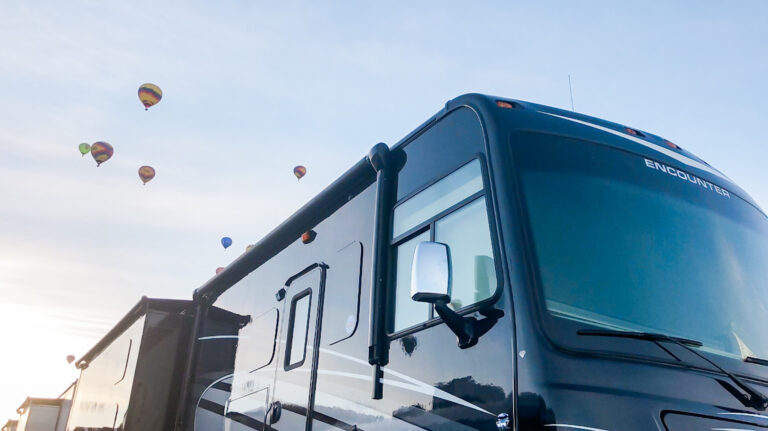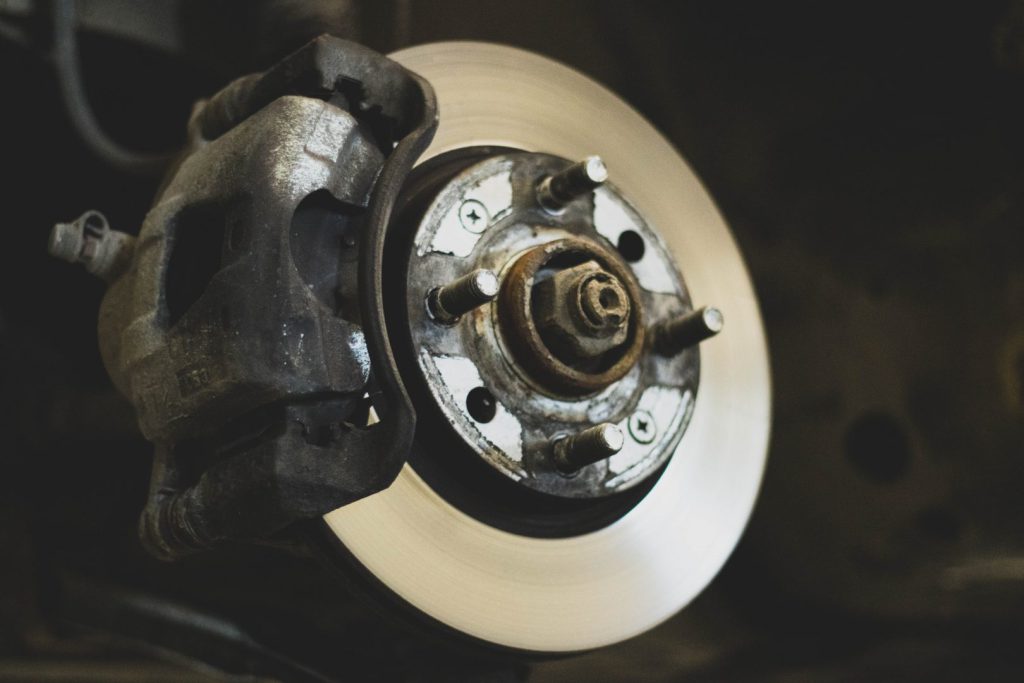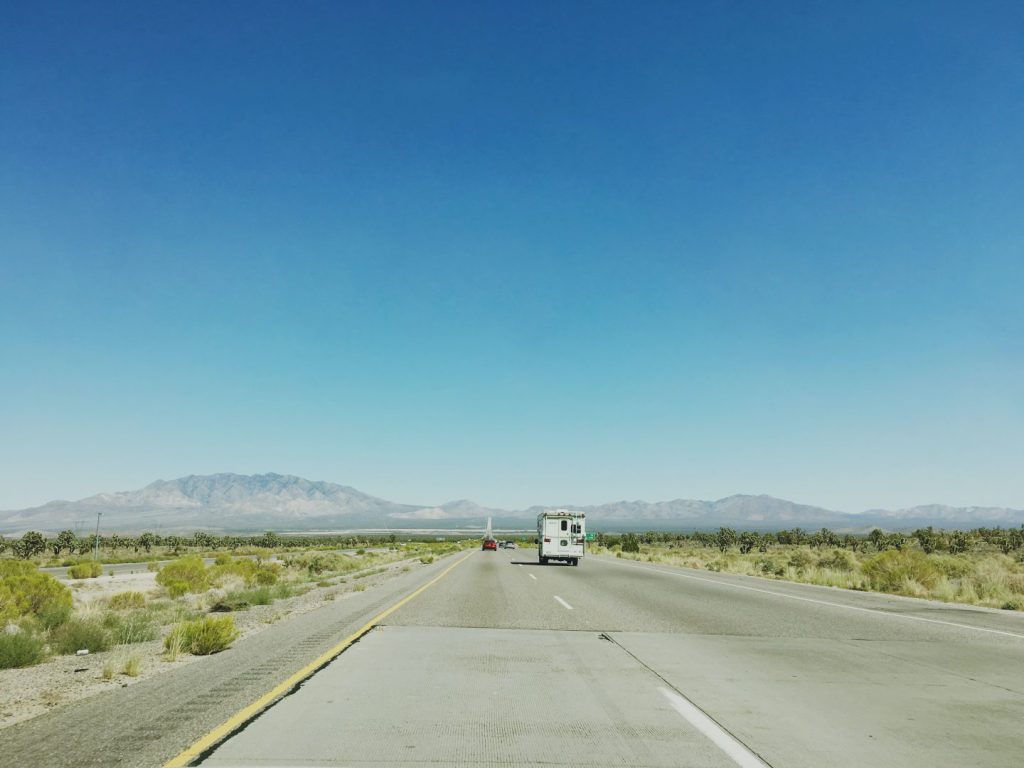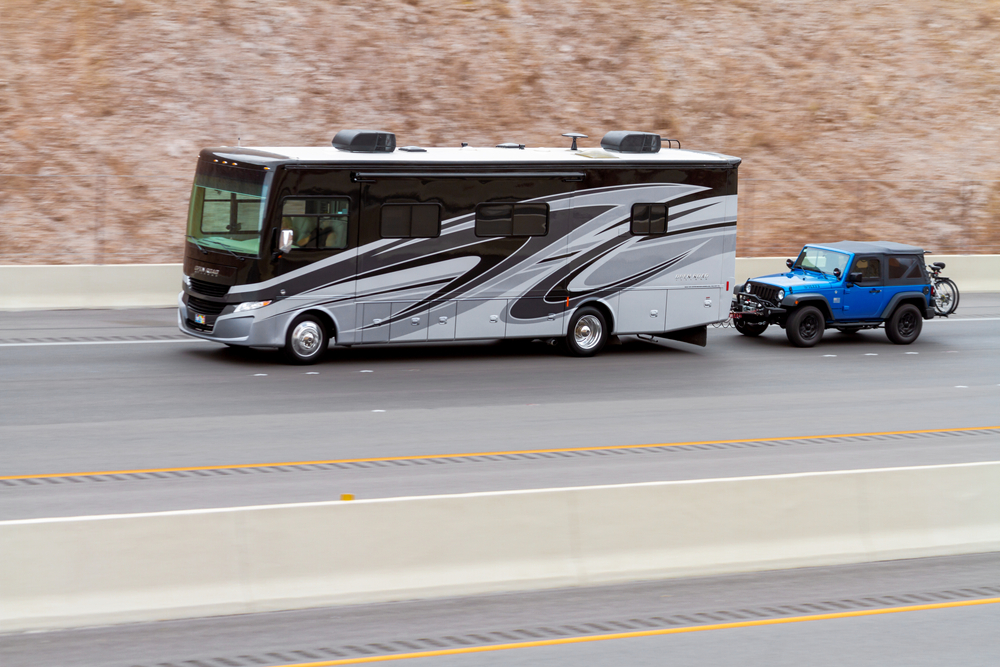
Whether you’re a seasoned road tripper or a first-time RV owner, understanding your RV’s brakes and how to properly tow a vehicle with brake controls is essential for both safety and peace of mind. In this guide, we’ll dive deep into the world of RV brakes, exploring various types of braking systems, brake maintenance tips, and the crucial role RV brake control systems play in ensuring a smooth and secure towing journey.
Types of RV Braking Systems
The first question you might ask is, “How do RV brakes work?”
The answer: Well, there are different types of RV braking systems and each one works a bit differently.
Hydraulic Brakes
Hydraulic brakes are what you’ll find in large RVs. In vehicles with hydraulic brakes, pressure on the brake pedal causes a master cylinder to push brake fluid through the system. This in turn pushes the brake pads or shoes and applies pressure to either a brake drum or the disc/rotor. This friction causes the wheels to slow down, bringing the vehicle to a stop.
Air Assist Brakes
Most motorhomes that are diesel-powered need more braking power than hydraulic systems can offer. In these cases, manufacturers tend to turn to air braking systems. In these systems, compressed air is used to quickly and forcefully push the brake pads into position, causing the vehicle to stop. They have fewer points of failure and offer more stopping power for big rigs.
Electric Trailer Brakes
Some travel trailers and fifth wheels use hydraulic braking systems like the ones described above. Others use an electric system. When a trailer uses electric brakes, it must be plugged into the tow vehicle. Electric trailer brakes use a brake controller. The system can sense when your vehicle brake pedal is being applied and will tell the pads to engage when this happens. It ensures proportional braking, distributing the braking force between the towing vehicle and the trailer, thus improving control and reducing stopping distances. Travel trailers typically do not come with built-in brake control systems. Trailer brake controllers are separate components that need to be installed and integrated with your specific towing vehicle’s braking system
Auxiliary Braking Systems
In addition to the main braking systems above, many motorhomes and large trucks are also equipped with auxiliary braking systems. These work by slowing the engine and/or transmission in order to slow the vehicle down. They are not meant to be used as a primary braking system but can help you slow down when driving downhill, or assist your primary brakes in emergency braking situations.

Using Your RV Brakes
RVs are big heavy vehicles, and stopping them takes a little more time than stopping a small car— especially if you’re towing an extra vehicle!
That said, there are a few points we feel we should make that will help keep your RV brakes in tip-top shape and keep you and your family safe while out on the road.
#1 Always Leave Plenty of Space
Keep this in mind when driving and always leave plenty of space between you and the vehicle in front of you. This will ensure you have time to use those well-maintained brakes should traffic come to a stop for any reason.
#2 Brake Early and Slowly When Possible
When you do stop, try to avoid slamming on the brakes. Instead, apply the brakes before you would in a car, and ease into the stop. This gives you extra time to stop and helps conserve the parts of your brakes that see the most wear.
#3 Know When to Use Auxiliary Braking
If your motorhome or tow truck is equipped with auxiliary braking, know when to use it. You don’t want to use it every time, as brakes actually work best when they’re hot and they won’t get hot if they aren’t doing enough work.
That said, your auxiliary braking system should definitely kick in if you do find yourself in a situation where slamming on the brakes is necessary. Additionally, you should always have the auxiliary brakes turned on when driving in the mountains, as it will keep you from applying your brakes too often and wearing them out or burning them up.
Don’t have auxiliary braking? If you plan to do any mountain driving, you will want to drive in a lower gear to get the same sort of result and avoid riding your brakes.
#4 Listen and Feel for Problems
While you’re driving your RV, make sure you’re always paying attention to the way the rig feels and sounds. If you hear noises such as grinding or squeaking while braking, or if the brakes feel like they aren’t working quite right, you will want to head straight to a mechanic. After all, RV brakes aren’t something you want to find yourself without!
RV Brake Maintenance
Now that you know the different types of RV brakes and have an idea of how to safely use them, the next thing you need to know is how to care for your RV brakes. RV brake maintenance will differ a bit depending on which type of brake you’re working with, so you won’t need to do everything listed below, but instead do the tasks that apply to your specific RV.

Replace Pads on Disc Brakes-
If you have disc brakes, your brake pads are the things that need to be checked and changed most often. Check these every 6 months or after long trips through the mountains. Pads should be at least 3/16” thick from the center of the pad. Many people prefer to change these sooner, especially on bigger vehicles, as they require more stopping power. Fortunately, RV brake pad replacements are relatively inexpensive and many handy people can do the job themselves.
Rotate Rotors on Disc Brakes-
While you’re checking your pads, be sure to also take a peek at your rotors. The rotors see a lot of wear and should be rotated every other brake pad change to ensure you don’t see warping or grinding. If warping, grinding, or other imperfections have occurred, or if the rotors are worn thin, you should replace your rotors entirely, something that will add to the time and cost investment.
Check Drums on Drum Brakes-
If you don’t have disc brakes, you have drum brakes. These are most commonly seen on trailers and older motorhomes. That said, they can be found on newer motorhomes as well. If your RV has drum brakes, you will want to check your drums for deep grooves, hard spots, or burned places. If you find these things, the drums may need to be turned, reground, or replaced. While you are at it, go ahead and check the brake shoes and magnet and give the drum a good cleaning with brake cleaner and a stiff bristle brush.
Replace Brake Fluid in Hydraulic Systems-
RV brakes can see some seriously high temperatures, but brake fluid is not affected by heat. That said, water is affected. While a hydraulic braking system is a closed system, it can still absorb moisture over time through condensation.
The water that makes its way into this system is a problem because it mixes in with the brake fluid and turns to steam once high enough temperatures are reached. Steam is more easily compressed than liquid and evaporates, meaning not as much pressure is put on the brake pads when the liquid is pushed through the system. This leaves you with spongy brakes—or worse, brakes that don’t work at all.
For this reason, it’s important that you drain and replace your brake fluid completely at least as often as your RV’s manufacturer recommends, to ensure you remove any water in the system. Additionally, since low brake fluid can cause similar issues, it is recommended that vehicle owners check their brake fluid level regularly and top up if it’s looking low. Some RV brake fluid reservoirs are clear so you don’t have to remove a lid to check.
Just make sure you check with your chassis manufacturer for instructions specific to your system and to ensure you have the correct fluid.
Drain Air Reservoir in Air Brake Systems-
Air braking systems do not have brake fluid to maintain, but they do have an air reservoir that stores compressed air. Unfortunately, this reservoir tends to collect water and oil, which makes its way to the drain valves and must be cleaned out every 6 months or so.
While some air brake systems have an automatic drain valve flush feature, many require you to do this task manually. You will need to check with your chassis manufacturer for instructions that are specific to your RV.
Replace Filter in Air Brake Systems-
Another maintenance task that air braking systems require? Filter replacement. The filter in an air brake system is used to help collect unwanted moisture and oil. Over time, this filter can become quite clogged, something that reduces airflow and weakens braking.
Since you definitely want your brakes to work as well as they possibly can, it’s recommended that you change this filter every 2 to 3 years. This will ensure your filter always allows enough air to pass through.
Adjust Electric Trailer Brake Controller
Your electric trailer brake controller should give you the option to set the pressure of your brakes on a scale of 0–10. Some brake controllers are self-calibrating, in which case you can skip this step entirely. Otherwise, you will need to calibrate the brake controller manually.
You’ll have to experiment with your trailer and tow vehicle to know where to set your controller. We recommend taking your RV to a gravel lot to set your brakes. Ensure your trailer is plugged into your vehicle. Start with the controller set to 4 or 5 and tow the RV through the gravel at about 20 mph. Apply the brakes and observe what the trailer does. If the brakes lock up, you need to adjust down. If the trailer stops too slowly, adjust up. Continue the process until the trailer stops correctly.
You will need to change this setting if you get a new tow vehicle, get a new trailer, or anytime the weight of your trailer drastically changes.
Check the Electromagnet on Electric Trailer Brakes
Another thing you’ll need to do to keep your trailer brakes working well is keep an eye on the electromagnet. This is located in the brake drum and should be able to move in and out of its cradle, but should not be loose or disconnected.
There are also wear indicators on these magnets. Check yours to ensure it isn’t time for a magnet replacement.
Finding Brake Parts
Ready to jump into your RV brake maintenance but unsure where to find brake parts? Fortunately, most motorhome and trailer brake parts can be found on Amazon. That said, if you’re having trouble finding a particular part, we can also recommend eTrailer or even a local auto parts store.

RV Brake Control Systems
When towing, it is necessary that you use a supplementary RV braking system to keep you, your ride, and your tiny home on wheels safe. All RVs, cars, trucks, and SUVs come equipped with their own electric braking systems, but in order for your RV and tow vehicle brakes to work together, you must have a control system.
In fact, the United States, federal regulations state that any trailer with a gross vehicle weight rating (GVWR) of over 3,000 pounds must have a brake control system that is operable from the towing vehicle. However, individual states may have additional or specific requirements, so it is important to familiarize yourself with the regulations of the state(s) you’ll be traveling in.
RV brake control systems can be permanently installed in vehicles or motorhomes. This would take a few hours and requires the services of a professional, but after the installation, only a few minutes are needed to hook up the RV to the tow vehicle.
RV braking systems can also be portable. These will require installation whenever you want to tow, however, they are relatively easy to install/ uninstall.
How do Towed Vehicle Brake Controllers Work?
While the basic principle of controlling RV brakes applies to both motorhome and travel trailer brake controls, the installation and wiring methods may differ. Motorhome brake controls are typically installed in the towed vehicle’s driver compartment, while travel trailer brake controls are installed in the towing vehicle’s driver compartment.
A towed RV brake control system is designed to slow the brakes on your towed vehicle — also known as a toad or dinghy — in sync with your motorhome’s brakes so they don’t collide. It works by using electricity from the tow vehicle to apply just the right amount of force (also known as “gain”) to your towed vehicle’s brakes. This is done through some electrical circuits and settings that regulate the amount of braking force.
Some brake controllers have circuits that automatically adjust to your vehicle’s momentum while towing, while others apply braking force on a pre-determined scale that you set yourself (like we previously mentioned above). Either way, you can rest assured that your RV brake controller will help you have a smooth and safe braking experience while towing.
Types of Towed Vehicle Braking Systems
When it comes to RV brake control systems for towing, there are different types available that operate in different ways. Here’s a quick breakdown of the difference between proportional, direct, progressive, and vacuum-assist RV brake control systems:
- Proportional braking: Uses sensors to detect the amount of braking force being applied to the RV. The system then applies the same amount of braking force to the towed vehicle, making it a proportional response. The braking force applied to the towed vehicle increases or decreases in proportion to the amount of braking force applied to the RV. This is the most popular type of braking system for most RVers.
- Direct braking: Operates by using a direct physical connection between the RV and the towed vehicle’s brake pedal. When the driver applies the RV brakes, the direct braking system immediately applies the same amount of braking force to the towed vehicle.
- Progressive braking: This system applies a preset amount of force to the towed vehicle’s brakes initially, but the amount of braking force increases progressively as the RV slows down.
- Vacuum-assist braking: Uses a vacuum source from the motorhome engine to power the brakes of the towed car. The vacuum is transferred to the toad’s brake booster, which applies the brakes when the motorhome’s brakes are applied — just as if you were behind the wheel of the toad. This system is best for older vehicles with power-assist brakes.
The Best Towed Vehicle Brake Control Systems

The following are the most popular RV braking systems on the market:
Blue Ox Patriot Portable Supplemental Braking System
This system uses proportional braking to control your tow vehicle’s brakes from the driver’s seat of your motorhome. Place this self-contained unit braking system on the floor of the driver’s side. Attach the brake claw to the brake pedal, and plug the unit in, so it can calibrate. The Patriot applies the brakes by using an electric cylinder and actuator. It retails for around $1,900.
Features:
- Works on all vehicles including hybrids
- All electric with built-in battery
- Lightweight
- Continuously monitors break pressure during towing
- Emergency brake function
Roadmaster Invisibrake
This fully-automatic, progressive supplemental braking system retails for around $1,000. It is installed beneath the front seat of the toad so there’s nothing to have to connect and disconnect once it’s in. After installation, just set it and forget it!
Features:
- Works with virtually any tow vehicle
- Emergency break-away system
- Installed out of sight
- Easy install
Roadmaster Brakemaster
This direct proportional, permanently-mounted brake system retails for $825. The Brakemaster is connected directly to the motorhome’s hydraulic brake line or air line. It takes four to six hours to install these braking systems initially. After installation, all you will need is a minute or two, to attach and disengage the Brakemaster.
Features:
- Affordable
- Breakaway emergency system
- Easily connects and disconnects from pedals
Danco RVibrake
This portable, supplemental braking system integrates tire pressure monitoring and braking. It retails for $1,595.00. The RVibrake is also placed on the floor of the towed vehicle, so there is no wiring or installation needed. When you are ready to go, just push the start button — the system is activated by inertia.
Features:
- Comes with a 3-year warranty
- Lightweight, weighing just 8 pounds.
- Simple one-button interface that automatically positions itself to your brakes
- Brake lock detection with audio assistant guide to avoid damaging brake pads
- Guaranteed to fit in any vehicle
Air Force One Braking System
This is a permanently-mounted 100% direct proportional braking system, and retails for around $1,300. This system is mounted near the rear axle of the coach. The operating unit is installed under the hood of the towed vehicle and allows you to be towing-ready in seconds.
Features:
- Air system — no moving parts to wear out
- Effective, yet out of sight
- Total coach protection to protect your towing vehicle’s air supply
- Demco patented actuator
- Fits all vehicles including hybrids
Stay-In-Play Duo Braking System
This is also a permanently-mounted brake system. The unit retails for $1,000 and is secured using stainless steel ties in the hood of the towed vehicle. The brake pad is secured over the brake pedal. The tow vehicle’s wiring, acceleration, deceleration, and braking are all monitored. Various amounts of pressure are used to brake, depending on the variables.
Features:
- Zero setup, always ready to tow
- User-friendly operation, no complicated electronics
- Panic stop braking
- Small in size and mounts under the hood, so you’ll forget it’s even there
- Smooth and responsive braking
All states and provinces in Canada require that towed vehicles have a supplementary braking system installed. There are many other popular RV braking systems available. Take a moment to think about how you’ll use your towed vehicle – if you’re going to use it a lot, you may want a permanent system, rather than a portable one. If you don’t travel as often or if you have multiple vehicles, you’ll want the portable system so you can switch between cars. With a little online research, you should be able to find the perfect braking system for your needs!
Safe travels!
This post contains affiliate links. RVshare may receive compensation if you make a purchase after clicking on a product or service link.

